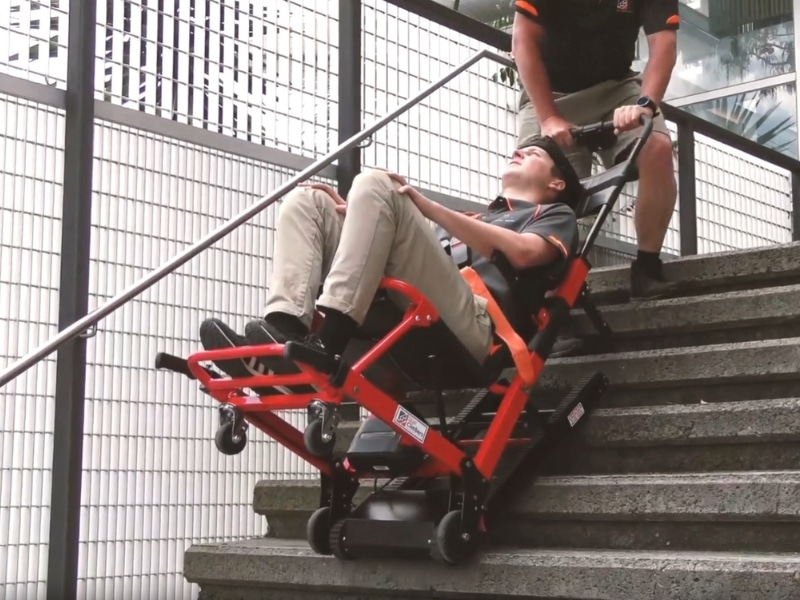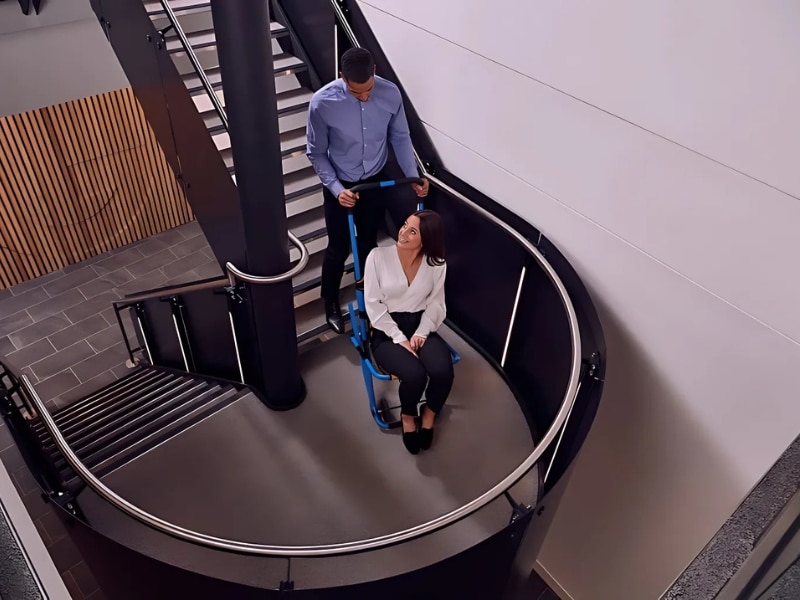When space is limited, every centimetre counts—especially on staircases. The types of stair climbers you choose can make or break everyday mobility, storage, and safety in tight areas. With models ranging from compact motorised trolleys to rehab-ready chair lifts, understanding your options is critical. Using the wrong device could block access, pose safety risks, or result in it collecting dust. Many stair climbers look similar on paper, but they solve different problems depending on who’s using them and how narrow your stairs are. This article covers the most efficient types for small homes, clinical settings, and portable use in compact interiors.
What are the most common types of stair climbers?
If you’re narrowing down your options, start by understanding the categories. Each stair climber type serves a different purpose, and some are more suitable for use in confined spaces than others.
- Motorised hand trolleys: Compact cargo solutions. These models help you transport goods or heavy equipment up narrow stairs with less effort.
- Portable chair lifts: For person-to-person use, these foldable seats climb stairs with a user onboard and are handy in shared residential homes.
- Evacuation chairs are Ideal in emergencies, as they are lightweight and foldable, making it possible to move people downstairs during power outages or fires quickly.
- Tracked stair climbers: Great for stability. These devices utilise rubber tracks to grip each stair for safer movement, especially when navigating tight landings.
- Wheelchair stair climbers: Designed for accessibility, these lifts enable individuals to remain seated in their wheelchairs as they move up or down stairs.
Each category meets a distinct need, but if you’re working with limited stair width, oversized models may slow you down or get in the way.
What problems do different stair climber types address?
Tight corners, uneven surfaces, and awkward turns are more than everyday hassles—they’re real barriers for many users. Different stair climber types solve various pain points.
- Corner turning difficulties: Solved with pivot-wheel bases. These enable smoother transitions on winding or spiral stairs.
- Weight and strain: Reduced by electric motors, Many models are designed to minimise the lifting load during vertical transport.
- Storage limitations: Handled by folding frames. Some stair climbers are slim enough to slide into a cupboard or under a bed.
- Shared living spaces: Improved by noise control, Quiet motors, and adjustable grips, these features help maintain peace in compact households.
Many users also need multi-purpose tools. One wise choice for this is stair climber types that offer limited mobility support, balancing user-friendliness with adaptable stair compatibility. These machines bridge the gap between healthcare, emergency, and home use.
Can choosing the wrong type of stair climber cause issues?
Yes—and those issues go beyond inconvenience. Selecting the wrong model can introduce risk and make regular use impractical or even unsafe.
- Over-width models: Block stair use, Devices that are too wide can make it difficult for others to pass or may scrape the railing.
- Improper incline handling: Causes slippage. Some stair climbers aren’t designed for steep or uneven steps.
- Inadequate weight support: Weight ratings must match the person or item being carried to avoid failure.
- Low clearance design: Limits manoeuvrability. Tall units may struggle under low ceilings or confined landings.
Frustration often follows when expectations don’t match performance. That’s why it’s essential to compare specs before you buy. One safe option is to choose from reliable types of stair climbers that cater to varied mobility needs, specifically designed for different space layouts and weight limits. A mismatch might not be evident until it’s too late.
How do various stair climber types compare for home use?
Comparing types for in-home settings helps you see how features stack up against real-life limitations. You’ll want to factor in the daily routine, hallway width, and who will be using the unit.
Stair Climber Type | Best For | Portability | Storage Friendly |
Portable Chair Lift | Elderly or rehab users | High | Yes |
Fixed Chair Lift | Long-term users | Low | No |
Evacuation Chair | Emergency planning | Very High | Yes |
Motorised Hand Trolley | Goods and boxes | Medium | Yes |
Tracked Stair Climber | Dual person/item use | Medium | Yes |
- Portable designs: Best for shared use, fold away easily and suit multi-user homes.
- Fixed rail options: Great for permanent installs, Ideal if mobility needs won’t change.
- Evacuation chairs: Emergency-ready, Quick deployment during power cuts or disasters.
- Hybrid models offer flexibility and are useful for transporting both people and goods.
For further perspective, consider exploring accessibility improvements using stair climbers in narrow areas, which demonstrate how these machines function in multi-storey homes.
What should you look for in a home stair climber type?
The ideal stair climber doesn’t just move—you’ll want something that handles your stair layout and fits your lifestyle. Here’s what to keep in mind.
- Weight capacity: Check manufacturer limits, ensure it handles your body weight or the heaviest items you’ll move.
- Motor power and control: Matters for longer stairs, Higher wattage motors and variable speeds boost efficiency.
- Maneuverability: Look for grip and tilt features, which help manage sharp corners and uneven steps.
- Noise level: Especially relevant in flats, Quiet operation prevents disturbing neighbours or other household members.
Over-specced models can feel clunky, while underpowered units often break down early. Suppose your needs involve aged care or mobility support. In that case, you can rely on guidance for modifying homes to support stair-climbing equipment tailored to specific health conditions. The right fit should feel seamless, not forced.
Are certain types of stair climbers more suitable for rehabilitation?
Definitely—rehab users need safe, supportive, and easy-to-control units. These models should assist, not challenge, the recovery process.
- Knee and hip rehab: Use padded seat options. Soft seating reduces strain during transition.
- Neurological recovery: Benefits from smooth starts, Gradual movement helps avoid shocks or jolts.
- Assisted transfers: Prefer swivel-seat designs. These help carers with safe entry and exit.
- Height-adjustable models: Reduce falls, Customisable fit supports various postures and step heights.
One commonly used solution is the Kris II Chair Lift, designed for healthcare-grade control and comfort. Overbuilt units with too many features often confuse patients, delaying their rehab progress. Choose models that support safety and independence, not just flash.
Final thoughts
There’s no perfect device—but there is an ideal fit. If you know your stair layout, space restrictions, and who’s using the climber, you can confidently narrow down your options. Instead of choosing based on appearance or price alone, focus on what feels natural to use every day. Your stair climber should make life smoother, not more complicated. If you’ve narrowed it down but still feel on the fence, you can always ask Stair Climbers which model fits your space to get practical insight from people who deal with these challenges every day.

